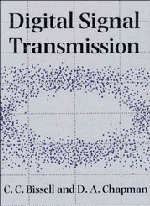Book contents
- Frontmatter
- Contents
- Preface
- 1 Introduction
- PART 1 MODELS
- PART 2 PROCESSES
- PART 3 DIGITAL TRANSMISSION OVER THE PUBLIC SWITCHED TELEPHONE NETWORK
- Appendix A Fourier series and transforms
- Appendix B Convolution
- Appendix C Modelling applications of spreadsheets
- Answers to numerical exercises
- References
- Index
PART 1 - MODELS
Published online by Cambridge University Press: 05 June 2012
- Frontmatter
- Contents
- Preface
- 1 Introduction
- PART 1 MODELS
- PART 2 PROCESSES
- PART 3 DIGITAL TRANSMISSION OVER THE PUBLIC SWITCHED TELEPHONE NETWORK
- Appendix A Fourier series and transforms
- Appendix B Convolution
- Appendix C Modelling applications of spreadsheets
- Answers to numerical exercises
- References
- Index
Summary
The two chapters of this part are devoted to models of signals, systems and noise. Such models have long been vital tools of the telecommunications engineer: many of them, in fact, date back to the early days of telegraphy, although they are applied in very different ways to modern telecommunications systems. A number of themes running through the next two chapters can be identified. First, there is the important notion of equivalent descriptions of signals as waveforms in the time domain or as spectra in the frequency domain. Secondly, there is the contrast between signals which are specified in advance for all time – the deterministic signals of Chapter 2 – and those non-deterministic or random waveforms, such as noise, which require the statistical techniques introduced in Chapter 3. Finally, there is an emphasis on the way engineers – rather than mathematicians or system theorists – use these models in the design and analysis of digital telecommunications systems.
As mentioned in Chapter 1, mathematical theory has been kept to a minimum, and a number of standard mathematical results have been collected as Appendices A and B rather than included in the main text. The reader is also referred to other standard works where appropriate. This is not to detract from the importance of mathematics for digital telecommunications, but rather to put the emphasis where it belongs: on a deep understanding of the functions and limitations of the models used, and on the need to interpret such models in their engineering context.
- Type
- Chapter
- Information
- Digital Signal Transmission , pp. 13 - 15Publisher: Cambridge University PressPrint publication year: 1992

